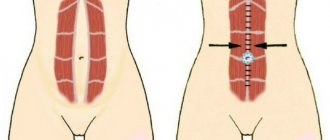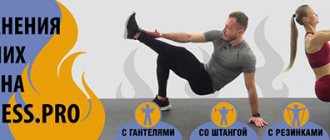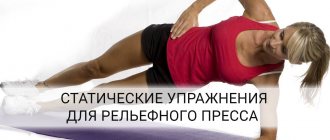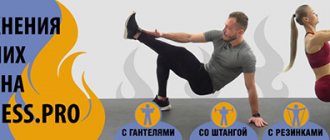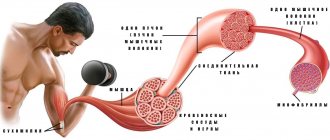Caesarean section is a surgical method of delivery (an incision is made in the abdominal cavity and uterus to remove the baby and placenta), which is used if there are contraindications to natural childbirth.
The operation is not dangerous or complex, but as a result of it, the woman’s postpartum recovery period is prolonged (when compared with natural childbirth). Initially, this is expressed in later milk production and a prohibition on picking up the baby. Afterwards, sagging and slow retraction of the abdomen are noted.
What does the belly look like after a caesarean section?
The belly after a cesarean section, unlike the belly after a natural birth, is not just increased in size, it is additionally divided by a suture into 2 parts. The abdominal incision can be made either horizontally or vertically.
With a vertical seam, fat folds form on both sides; with a horizontal seam, the stomach hangs over the seam. If a woman has a small layer of fat, then the skin looks pulled towards the incision site like wrinkled tissue. A year later, a noticeable scar remains on the abdomen.
Why you can’t exercise immediately after a cesarean section
Caesarean section is, although quite standard, still an abdominal operation that has an impact on the woman’s body. During its implementation, the anterior abdominal wall is subjected to mechanical stress, which violates its integrity.
Even in modern conditions of developed medicine, when the risks of complications are minimal, it is necessary to understand that the scar healing process requires enough time. Women who do not take a responsible approach to the question of when can they pump up their abs after a cesarean section, and start training too early, can experience a number of complications.
Hasty physical exercises with stress on the abdominal muscles can lead to such consequences as:
- high intra-abdominal pressure;
- discomfort and pain in the scar area;
- risk of seam divergence.
In order to minimize risks, it is worth consulting with a doctor who can assess the condition of the suture and the preparedness of the body as a whole.
Causes of sagging and asymmetry
The main reasons for sagging skin tissue and the development of asymmetry include the following factors:
| List of reasons | a brief description of |
| Stretching the skin on the abdomen | As the child grows, the uterus increases in size and gradually stretches the skin of the abdomen. After delivery, the tissues are gradually restored to their natural state. But if a woman was actively involved in sports before pregnancy, then the recovery process after childbirth proceeds faster. |
| Hormonal disbalance | During natural childbirth, the body produces hormones that are responsible for contraction of the uterus and normalization of the activity of the entire body. During a caesarean section, there is a disruption in hormonal levels, as a result the body recovers more slowly. |
| Deposition of adipose tissue | During pregnancy, the body stores “strategic” reserves of fat in the abdomen and thighs, so that after childbirth, “accidental” fasting does not disrupt the lactation process. Fat cells are an additional reason for the slow retraction of the abdomen. |
| Sedentary lifestyle | Due to the likelihood of suture divergence on the uterus or the anterior wall of the abdomen, restrictions on mobility and a ban on physical exercise are introduced in the first months. This leads to the appearance of additional fat deposits and muscle tissue atrophy. |
| Violation of tissue integrity both in the abdominal cavity and in the uterus | During a caesarean section, a cut is made in the muscle fibers, which take time to recover. This additionally does not allow the tissues to quickly return to their natural state, and can also cause the development of asymmetry in the abdomen. Due to the cutting of the uterine tissue, it shrinks in size more slowly. Maintaining belly size. Also, during the recovery process, the outflow of fluid is disrupted, which provokes a slow decrease in the volume of the abdomen. |
| Changes in posture during pregnancy | During the period of bearing a child, the center of gravity shifts, which leads to a slight stoop. And also, throughout pregnancy, the abdominal muscles are in a relaxed state (otherwise, the tone of the uterus may increase). Slouching and relaxed muscles persist for the first time after childbirth, which visually increases the size of the abdomen. |
| Violation of skin structure | During pregnancy, the amount of collagen in the body decreases (responsible for the elasticity and firmness of the skin), as a result, the skin on the abdomen looks flabby and cannot tighten. |
| The number of fetuses and how long the pregnancy is. | With multiple pregnancies, as well as if this is not the first pregnancy, there is a stronger stretching of the tissues, making it more difficult to remove a sagging belly. |
| Diastasis | It is expressed by the divergence of the rectus muscles in the navel area by a distance of more than 3 cm. As a result, sagging tissue occurs. Pathology often begins to develop during pregnancy. |
An additional reason for sagging and asymmetry of the abdomen is the professionalism of the surgeon. If the doctor made a large incision in the anterior wall of the abdomen or uterus, made an incorrect cut in the muscle fibers, or nerve tissue was damaged, the recovery process will be delayed for a longer period.
Lightweight abdominal exercises
If after two months the woman feels well, and the obstetrician-gynecologist speaks of a successful recovery period, you can begin classes. At the first stage, it is necessary to select a type of exercise where the abdominal muscles are involved indirectly. Preference can be given to swimming, Pilates, and steady cycling. You can do the following exercises at home:
How long will it take for the stomach to tighten on its own?
The abdomen after a cesarean section returns to its natural shape in 6-18 months.
The duration of the recovery period depends on the following factors:
- how quickly the uterus will contract. With a natural birth, this will take 14-30 days. For caesarean section up to 6 months;
- how quickly damaged tissue in the uterus and anterior wall heals. On average, this period takes 2-3 months;
- the speed of restoration of hormonal levels, which regulates the normalization of the body’s activities;
- whether the child is breastfed. When breastfeeding, a special hormone is produced that accelerates uterine contractions;
- lifestyle after childbirth (diet, walking);
- playing sports before pregnancy.
It also depends on the individual characteristics of the body (metabolic processes, age, presence of chronic pathologies).
When can recovery begin?
After cesarean section, it is allowed to begin physical activity only after the damaged tissues have been completely restored (that is, no earlier than 2 months). You can clarify this information with a gynecologist who monitors the woman in labor during the recovery period. It takes into account the general condition of the patient, whether there were any complications during the recovery period, whether the sutures were overgrown (with an ultrasound required).
You can begin to tighten a sagging belly after a caesarean section only after the stitches have tightened
It is important that while physical activity is prohibited, it is necessary to reduce the consumption of fatty foods, take walks with the child, with the permission of the doctor, you can use specialized cosmetic products, this will speed up the reduction in the size of the abdomen.
In the absence of complications after cesarean section, light physical activity is permissible after 3 months (breathing exercises, swimming, yoga). You can switch to active sports no earlier than after 6 months, with a gradual increase in load.
Steps
Don't forget about safety
- Consult your doctor before exercising again.
Any
exercise after pregnancy must be approved by a doctor. This is especially true for complex surgeries such as caesarean sections, since if the mother is overworked, this puts additional stress on the sutures placed on the incision. Most new mothers will need to see a doctor at least once after surgery to make sure everything is healing properly. At this postpartum checkup, tell your OB/GYN that you would like to start exercising and ask when you can start.
- Note:
The contents of this article
are not
intended to replace medical advice.
- Wait at least six weeks before starting training.
Carrying a baby and giving birth can be a traumatic experience for your body, even if everything is fine.
For example, even in a normal pregnancy, a condition called muscle diastasis can occur, where the abdominal muscles move apart as the belly becomes enlarged. Additionally, a caesarean section will leave you with a scar that will take time to heal. This is why rest during the recovery period is especially important, even if you were in great shape before pregnancy
.Start with light exercises, without much stress.
Your first workouts after a cesarean section should be very relaxed, even if you did serious strength training or participated in marathons before pregnancy. Your muscles (in particular the muscles of the thighs and core) have been depleted by pregnancy and the accompanying lack of exercise, so you need to work on their restoration gradually. Don't force yourself; If you start working out too hard too early, you can get seriously injured.
- In the steps below
you'll find a selection of low-impact strength and cardio exercises you might want to try. Your doctor or physical therapist will also give you plenty of ideas to use.
With a calm rhythm of training, with a gradual increase in intensity, you should return to your previous shape within a few months after surgery.
Be patient - you've just gone through pregnancy and
major surgery, so the slight inconvenience of a slow workout routine is nothing compared to your health and safety.
As you return to your normal exercise routine, it's important to minimize the unnecessary stress you put on your body. Please take into account the basic precautions outlined below:
- take about five minutes to warm up and cool down during each workout;
at first, limit yourself to 10-minute workouts at a time, three times a week;
You can protect the wound from a cesarean section during exercise by using compression garments specially designed for recent women in labor. These items (names may vary, such as "recovery shorts") use gentle pressure to support C-section wounds while they heal, making them a useful item for new moms who want to get back in shape. While these items may not be cheap, many moms vouch for their effectiveness.
- Keep in mind, compression garments are not shapewear, and if that bothers you, you shouldn't be embarrassed to wear them (but that doesn't mean you should be embarrassed by shapewear).
Even if everything heals well, exercising after a C-section can be challenging. You will most likely feel tense. You will probably get tired faster than before. You may react too emotionally or lose motivation due to hormonal processes beyond your control. Try to overcome these barriers and exercise whenever you can - exercise will help you feel better and give you energy to care for your baby.
- If you often feel tired, sad, unmotivated, or blues, and don't feel like exercising after pregnancy, you may have postpartum depression. Talk to your doctor about the treatment plan that's right for you.
How to tone your muscles
- Do a bridge to strengthen your hips.
This simple, easy exercise will help strengthen important muscles in your hips and core. Step-by-step instructions for performing a bridge:
- Lie on your back with your feet shoulder-width apart. Knees bent at an angle of 45 degrees;
Squeeze your lower abdominal muscles as you lift your hips off the floor;
These exercises will help strengthen your pelvic floor muscles, which are responsible for balance and stability. Plus, Kegel exercises improve your ability to stop urine flow (sometimes a postpartum problem for women), and they can be done anywhere. Follow the steps below to perform Kegel exercises:
- identify the position of your pelvic floor muscles by squeezing the muscles that help stop the flow of urine (if you have trouble with this, wait until you go to the toilet). These are the exact muscles you'll be working during Kegel exercises;
focus on gently squeezing these muscles. You can do this in almost any position, although some find it easier to do while sitting;
A strong back is important for everyone, especially for good posture and avoiding lower back pain. Forward bends are performed as follows:
- Place your feet shoulder-width apart and place your hands on your hips;
raise your arms above your head. Begin to slowly bend down from the waist;
While strong abdominal muscles are important, abdominal exercises or sit-ups may be too intense for a woman who recently had a C-section. Start by doing an exercise called a plank, which will not put pressure on your wound. Follow the instructions:
- take a push-up stance (knees and palms on the floor);
get down on your elbows. At the same time, lift your knees off the floor;
Most postpartum exercise routines focus on the core, but don't forget about the arms and legs. Try the steps below to kill two birds with one stone:
- stand up, place your feet shoulder-width apart, arms to the sides;
use your fingertips to describe the smallest possible circles in the air, without moving your hands;
Do some cardio exercises
As long as you don't ride through big potholes, cycling can be a great form of exercise. The best thing about this is that it can be done either in the gym or at home if you have your own bike. You can attach a special baby stroller to your bike and ride with your baby (be careful!).
- Limit your riding to flat surfaces and not too steep slopes. Avoid driving on steep inclines or on bumpy roads as this may become a problem if your incision has not yet fully healed.
- In addition to recovery shorts and other equipment, you can wear a special belt during training.
- Try to involve your baby in the training process (very carefully, of course). For example, simply rocking your baby to sleep can be a great exercise if you also run circles around the room. On average, a newborn baby weighs just over three kilograms and gets heavier as they grow, so caring for a baby can end up being quite a workout.
Consequences of early exercise
A belly after a cesarean section is normal during the first months after delivery.
Therefore, early physical activity will not only not bring results, but can also cause the development of the following complications:
- The most dangerous thing is the divergence of internal seams. They can lead to internal bleeding, and in the absence of timely medical care and poor blood clotting, can be fatal;
- divergence of external seams. If the damage is small, a rough and uneven scar may form;
- development of abdominal hernia;
- discharge from the uterus of a pathological nature (may develop due to incomplete restoration of the organ);
- increased pain if the tissue is overgrown, but not completely restored.
If there are pathologies in the digestive tract or reproductive system, their exacerbation may develop.
When can I start?
Abdominal removal after cesarean can begin at 5–6 months. The timing is set by the attending physician. Training can be started only after the woman’s body has fully recovered.
If the postoperative period does not proceed correctly, power loads on the press can lead to such negative processes as:
- seam rupture;
- uterine prolapse;
- loss of lactation.
Suture rupture can occur due to uneven scar formation. Any heavy loads lead to stretching of the abdominal tissues. A thin section of the scar may come apart. To prevent this from happening, you should wait 6 months.
There is a risk of uterine prolapse. The organ in the abdominal cavity is secured by ligaments. During pregnancy, ligaments stretch and weaken. After a caesarean section, they gradually return the uterus to its normal position. If a woman chooses the wrong set of exercises, there is a risk of prolapse of the uterine cavity. Severe ptosis is accompanied by prolapse. Complete restoration of the ligaments occurs in the fifth month after cesarean. From this time you can start training.
Before removing the belly after a caesarean section, you should switch the baby to complementary foods. Complementary feeding begins at three months. Gradually the diet expands. Breast milk will not be the main food. By the age of six months, the baby can eat a variety of pureed meats and other products. From this time you can start training. If lactation disappears, the baby will not suffer.
How to remove belly fat without surgery?
It is recommended to eliminate the abdomen after cesarean delivery without surgical intervention. Since the operation will be another “shock” for the body and can lead to a decrease in milk production (and even complete cessation) or result in the development of complications.
Before choosing the appropriate method for eliminating the abdomen, it is recommended to first determine the cause:
- protruding belly (as in 6 months of pregnancy.) Means poor uterine contractions. To eliminate it, the gynecologist may prescribe drugs that enhance contractile activity;
- folds in the form of “rollers” stand out on the stomach. It is typical in the presence of excess subcutaneous fat and severe stretching of the skin tissue. It is recommended to adhere to dietary nutrition, perform cosmetic procedures and exercise;
- the abdomen is greatly stretched, and the skin hangs down in the form of an “apron”. This is how diastasis is expressed. An examination is required. Treatment methods are selected depending on the severity of the pathology.
It is important that any of the following methods for eliminating the abdomen are allowed only after consultation with a doctor.
Exercises for the abs
The classic version of the press swing is allowed no earlier than 8 months after cesarean section.
After 6 months, you can strengthen your abdominal muscles using the following exercises:
- lying on your side, while exhaling, pull your stomach in as far as possible and fix the muscles in this position for up to 5 seconds. Relax. Repeat the exercise 5 times on each side. Every 14 days, increase the load by 3-5 repetitions, bringing it up to 20 times. The exercise can be combined with feeding the baby;
- lie on your back, bend your knees. Alternately inflate and retract your stomach to the limit. Fix in each position for up to 5 seconds. Start with 5 approaches gradually increasing to 20 times;
- lying on your back, tense your abdominal muscles for 10 seconds. Repeat from 5 to 20 times.
These exercises can be performed 3 times a day.
The following exercises should be performed comprehensively (allowed 8-10 months after cesarean section), they help strengthen the abdominal muscles, spine and buttocks:
- plank You need to take a horizontal position (face down). Place emphasis on your elbows and toes. All muscles of the body should be in a tense state. Make sure that your back does not sag and your stomach does not sag. Fix for 10 seconds. Gradually increase the load to 1 minute;
- push ups. In a horizontal position (face down), focus on your palms and toes, keeping your back straight. Alternately rise (straighten your arms) and lower (bend your arms). Repeat from 3 to 15 times;
- press. Lie on your back, legs bent at the knees, arms straight above your head. Alternately take a sitting and lying position. Repeat from 5 to 20 times. The press can be replaced with a bicycle exercise (lying on your back, legs raised and bent at the knees, imitating riding a bicycle) or a scissors exercise (bed on your back, legs raised straight at an angle of 30 degrees, imitating the motion of scissors blades);
- strengthening the oblique muscles. Lying on your back, arms under your head, legs bent at the knees. Tilt your legs left and right with smooth movements. Repeat from 7 to 30 times;
- abs and spine. Take a horizontal position (facing the ceiling) resting on your palms and feet. Straighten one leg. Lower and lift your buttocks. Fix in each position for 3 seconds. Repeat 5-15 times;
- strengthening the waist muscles and straightening the spine. Lie face down on the floor. Hands in front of the face (as when playing hide and seek), legs straight. Slowly bend back and lower to the starting position. Repeat from 5 to 20 times.
Between each exercise, take a break for 1 minute with complete muscle relaxation. Gradually, the exercise complex can be repeated up to 3 times a day.
Other sports
You can strengthen your abdominal muscles, straighten your spine and eliminate excess fat deposits using the following methods:
| Method name | Execution Rules | Notes |
| Walks | This option is suitable in the first months after cesarean section. Fresh air helps speed up the burning of fat deposits. | It is recommended to combine it with walks with a child (in a stroller). |
| Breath | Take deep breaths through the nasal cavity (in this case, you need to draw in your stomach as much as possible) and exhale completely through your mouth, relax. Hold between inhalation and exhalation for 10 seconds. | The best result will be when performing procedures on the street or balcony. |
| Dancing | You are allowed to start with smooth dances without sudden movements, gradually increasing the complexity of the movements. | It is recommended to select the program individually. |
| Running, cycling | The best option is running (cycling) for half an hour at a stadium or in a forested area. At least 3 times a week. Or you can replace it with exercise on a treadmill or exercise bike. | In order for jogging to give the best results, it is important to follow breathing techniques. |
| Swimming | You can simply swim in the pool or do water aerobics (with your doctor's permission). | Swimming in the river is not recommended due to the possibility of bacteria entering the body. |
| Yoga | The set of exercises is selected individually by the instructor and carried out under the supervision of a trainer. | Exercises can not only eliminate the stomach, but also normalize psychological balance. |
| Fitness | The selection of exercise sets is made individually based on the state of health and the severity of the abdomen. | The severity of the exercises should be increased gradually. It is recommended to perform exercises under the supervision of an instructor. |
| Hala hoop (hoop) | Perform twisting movements of the hala-hoop on your waist for 10 to 30 minutes a day. | To carry out the exercises, it is recommended to purchase a special hoop with massage rollers. |
These methods can be combined, and it is also necessary to maintain a smooth transition from lighter types of exercise to more active ones.
Massage
The belly after a cesarean section not only looks large or saggy, but also flabby muscles. Both shortcomings can be eliminated at the same time using massage (it is recommended to perform it by a professional).
Manual manipulations will normalize metabolic processes, restore the elasticity of muscles and skin, and also activate blood circulation (this will speed up the process of tissue restoration).
When performing procedures, it is necessary to use specialized oils or creams that make the hands easier to glide and additionally restore the condition of skin cells. At home, you can perform light stroking of the abdomen, pinching and rubbing.
Recommended techniques for performing massage at home:
- 50 ml of honey is enough for massage (if desired, you can add essential oil, it will improve the condition of the skin).
Apply liquid honey evenly to the stomach and make light patting movements. When the honey changes color and resembles white plasticine (usually most of it settles on the palms at this time), your hands should be washed. The change in color and consistency is caused by the extraction of harmful substances from the skin. After washing your hands, continue the massage until the remaining honey is completely absorbed by the skin. Important, the procedure is painful; - pinch massage. It is done by pulling the skin with your hands alternately. As a result of the manipulations, the skin should acquire a pink color (not red and there should be no bruising). At the beginning of the session and at the end, rub the skin with your palms;
- vacuum. Produced using vacuum cans. They normalize blood flow and draw harmful substances to the surface of the skin. The disadvantage of this method is the formation of bruises. It is strictly forbidden to attach cups to the scar, even if more than a year has passed since the cesarean section;
- hardware. To perform a massage, use manual or mechanical massagers in accordance with the instructions.
It is important that the massage should be carried out in a course (selected individually). That is, one procedure or one session every 1-3 weeks will not give results.
Wraps
It is recommended to perform wraps in combination with physical exercise; they will accelerate the breakdown of fatty tissue and will help remove harmful substances from the body through sweat. To enhance the effect, it is recommended to take a warm bath before wrapping to open the pores.
Recommended compositions for wrapping:
- steam 100 g of dry seaweed in 1 liter of boiling water. Leave for 15 minutes. Distribute evenly over the abdomen and sides. Wrap the composition in cling film. Leave for no more than 60 minutes;
- Combine 200 g of blue clay with water until a thick paste forms. Apply the composition to the stomach, wrap with film. Leave for 40 minutes;
- dissolve 200 g of cocoa in 0.5 liters of boiling water. Wait until it cools down. Apply to stomach and sides. Wrap yourself in film. Remove the composition after 30 minutes;
- apply liquid honey to the stomach, wrap yourself in film. Leave for 30 minutes.
After the procedures, you need to take a warm bath. Next, apply nourishing creams to the dry body. The full course consists of 10 sessions. Repeating procedures is allowed at intervals of 4 weeks.
Cosmetic procedures
Cosmetics can normalize the tone of the skin, eliminate stretch marks and capillary networks. Before choosing creams, lotions and other drugs, you must first familiarize yourself with the composition (to exclude an allergic reaction), contraindications and possible side effects.
The following products can be used both independently and during massages and wraps:
- masks, creams and gels based on seaweed;
- products with hyaluronic acid help restore skin elasticity and tone;
- compositions based on honey, cocoa or white clay.
Recommended drugs:
- mumiyo;
- mom comfort;
- 9 months;
- Vichy;
- coffee scrub
Cosmetics are allowed after complete scarring of the suture. Before use, familiarize yourself with the rules for applying the compositions.
Garters, bandages, shapewear
To speed up the contraction of the uterus and prevent further sagging of the abdomen, experts recommend the use of a postpartum bandage, shapewear, or the use of special garters.
When choosing these products, it is recommended to pay attention to:
- material. Synthetics will irritate the skin and can quickly stretch;
- size. If the bandage or underwear is larger, its effect will be ineffective. A small size will be very tight, which can damage the functioning of internal organs;
- fastenings at the bandage, they must be firmly fixed;
- underwear and bandage should not have seams;
- color. Underwear and bandages should not stand out under the main clothing.
When a gynecologist recommends tying (they can more effectively speed up uterine contractions, prevent prolapse of internal organs and the development of diastasis) instead of wearing a bandage or shapewear, it is necessary to correctly implement the “swaddling” technique.
In a lying position, the material must be placed on the stomach, then crossed on the back and then on the stomach. Tie the knot on the side.
If done correctly, breathing with a garter should not be difficult (the garter should lift the stomach).
Do not forget to clean or wash your underwear and bandages in a timely manner. It is recommended to wear specialized products 2 weeks after cesarean section and up to 8 weeks. During the night's rest, the bandage or shapewear must be removed so that the tissue can rest and recover naturally.
It is important that high-quality bandages and underwear can be purchased at a pharmacy or specialized stores. When choosing, it is recommended to familiarize yourself with the contraindications.
Diet food
Dietary nutrition after childbirth must be carefully prepared, especially when breastfeeding. The body must replenish the lack of vitamins and minerals that were absorbed by the child during gestation. Also, an incorrectly chosen diet can lead to a cessation of milk production.
Experts recommend:
- eat more often, but in small portions. It is advisable to eat immediately after feeding so that milk has time to be produced;
- limit the consumption of fats and carbohydrates, but do not exclude them completely from the diet;
- increase the amount of meat, dairy products, as well as fresh vegetables and fruits in the menu;
- additionally take specialized fortified complexes to speed up the body’s recovery;
- Monitor your drinking regime to normalize lactation.
When creating a menu, give preference to hypoallergenic products and those that do not cause bloating. If a rash is detected in a child, it is necessary to identify and exclude the allergen product. The exact list of allowed and prohibited foods for mom can be checked with your pediatrician.
Exercises for the abs
“The main rule during abdominal training is a gradual and smooth increase in load. You can prepare your body for exercise just a few weeks after giving birth.”
Immediately after childbirth, wearing a bandage will help strengthen your abdominal muscles. But no longer than 2-3 hours in a row, because the abdominal muscles must learn to work. Carrying a baby in a sling also puts some stress on the abdominal muscles and thereby trains them. After the lochia ends, with the permission of the doctor, you can visit the pool. During swimming, all muscles work. This reflects in the best way on the figure. You can start with warm-up exercises, doing planks, and breathing exercises. We wrote about this in the article “Sports after Caesarean”.
General rules
To play sports after a cesarean section, follow the general recommendations and rules:
- At the beginning of each session, do a warm-up to warm up and prepare your muscles for work. You can do a couple of body bends, pull your knees towards your stomach, etc. At the end of the session, do some stretching as a cool-down.
- You need to pump up your abs regularly. At least 3 times a week. The abdominal muscles are very inflexible. To get results, training must be constant.
- Movements during exercises should be with minimal amplitude. Perform no more than 10-12 times in one approach.
How to remove belly fat while sleeping?
To ensure that the belly continues to shrink during the night, it is recommended to sleep on your stomach more often. This will increase the contraction of the uterus, and, consequently, the reduction of the abdomen.
Additionally, after night feeding, do not eat; just drink 200 ml of warm tea with milk (can be without sugar). If possible, normalize your sleep-wake time. Since regular lack of sleep also causes excess weight and slows down the recovery process.
Caesarean section is used when there are prohibitions on natural childbirth. The procedure itself is not painful or difficult, but during the recovery period there is often pain and there are restrictions on physical activity (including sitting, bending, picking up the child). Additionally, there are difficulties in eliminating a sagging belly.
Author: Kotlyachkova Svetlana
Article design: Mila Friedan
